Brand Audit 101: How to Conduct One for Your Brand?
Is your brand making the impact you think it is?
Without a proper brand audit, you could be overlooking slight warning signs, like inconsistent messaging, outdated visuals, or audience confusion. And in a crowded market, that disconnect can quietly cost you trust, loyalty, and sales.
A brand audit shows if your message is landing or missing. Without one, you risk confusing customers and weakening the trust you’ve built. It’s like taking a good look in the mirror to ensure your brand truly reflects the value of your business.
Curious about brand audits and how they work? Keep reading.
What is a Brand Audit?
A brand audit, also referred to as a brand assessment, is a structured check-up on how your brand is doing—both inside your business and out in the world. It’s about checking how your brand performs across every touchpoint.
There are three main parts a brand audit usually covers:
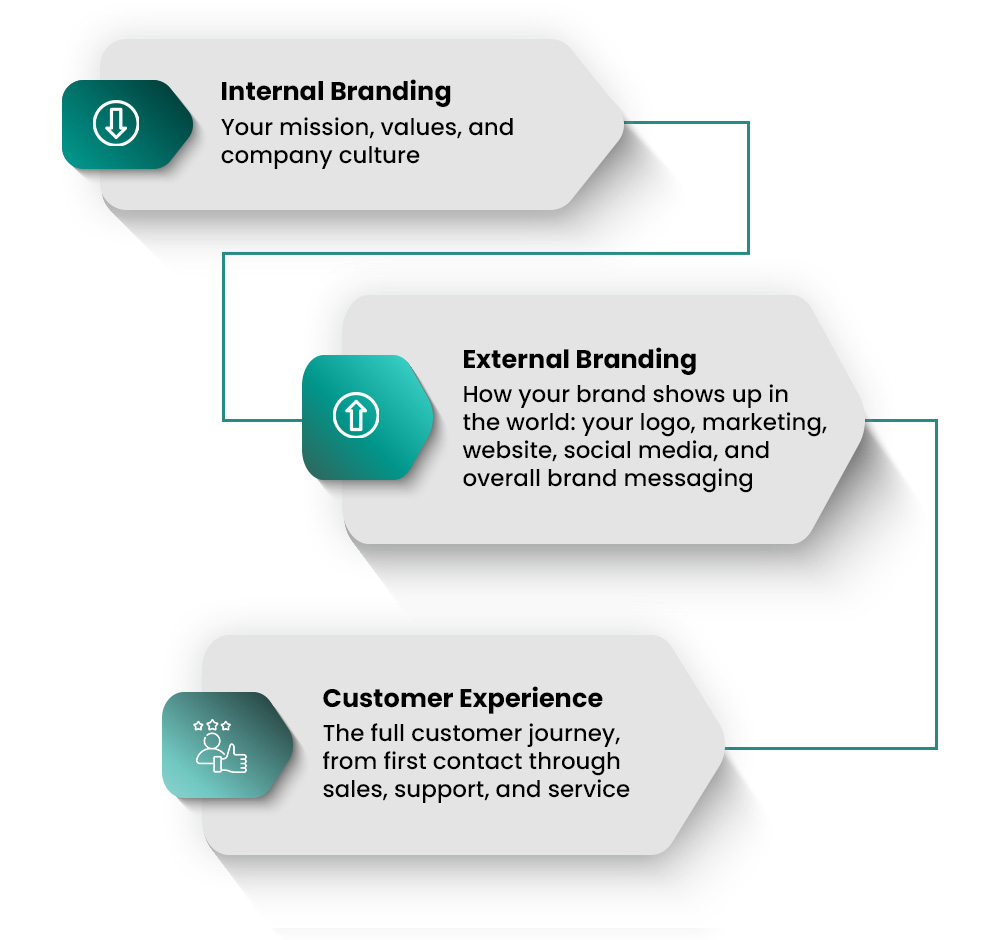
Doing a brand audit also means comparing how your brand competes against the competition. The goal is to find gaps or chances to get ahead.
Once it’s done, you’ll have a clear report that shows what’s strong, what needs work, and where to go next with your brand strategy.
Key Components of a Brand Audit
A brand audit isn’t about ticking boxes—it’s about making sure your brand still feels on point, sounds consistent, and delivers results. Here’s what to look at, and what each piece means.
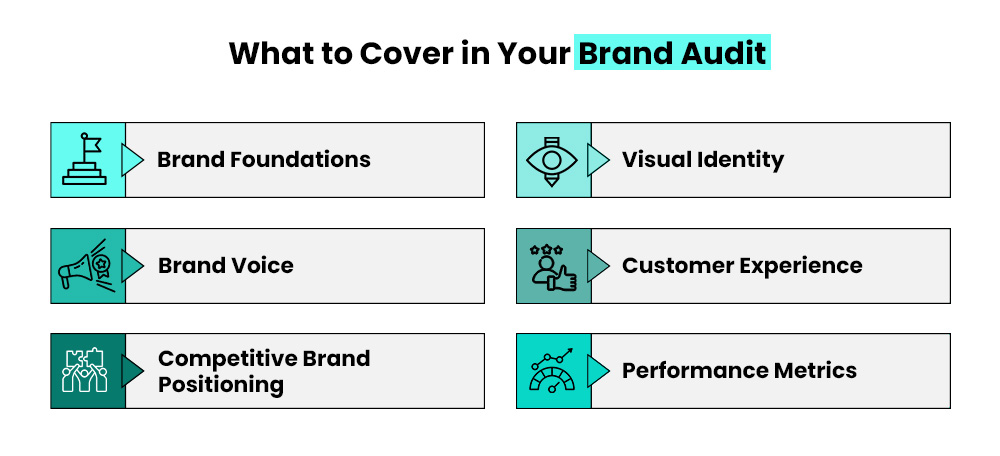
Brand Foundations
This is your “why.” It’s not about a fancy mission statement. It’s about whether your values show in your team’s actions, decision-making, and brand behavior. If your team doesn’t get it, your customers won’t either.
Visual Identity
It’s not just your logo. It’s how your brand looks and feels—on your website, packaging, Instagram stories, and email footers. A strong visual identity is instantly recognizable without needing to say your name.
Brand Voice
This is how you sound. Are you casual or formal? Friendly or bold? Your brand voice should be consistent whether someone’s reading your homepage or a DM. If it feels like different people are speaking, your brand will feel scattered.
Customer Experience
This is where talk meets truth. From first click to post-purchase follow-up—does every step feel smooth, thoughtful, and on-brand? Great experiences aren’t flashy; they’re frictionless.
Competitive Brand Positioning
It’s not just about who’s bigger—it’s about what makes you different. Are you solving something no one else is? Or doing it in a way no one else dares to? This is where your edge lives.
Performance Metrics
The numbers don’t lie, but need context to make sense. Without understanding the story behind the data, it’s hard to interpret what’s driving results or where adjustments are needed.
E.g., a spike in website traffic might seem positive, but if it’s not translating into sales, the data alone won’t reveal whether the issue is with the product, pricing, or customer experience.
Why is a Brand Audit Important?
Conducting a brand audit allows businesses to stay relevant, build stronger connections with customers, and adapt to changes in the industry.
It’s a health check for your brand, making it competitive and front-of-mind in a rapidly evolving marketplace.
Below are the key ways a brand audit actively strengthens a business and how it works in each aspect.
Identifies Strengths and Areas for Improvement
A brand audit looks at every part of your brand—from marketing strategies to how customers see you—to highlight what’s working and what could be improved. It evaluates your brand’s messaging, visual identity, and overall market positioning.
By analyzing customer feedback, competitor positioning, and brand consistency, businesses can identify strengths and areas for improvement. This helps them refine their marketing strategies, enhance the customer experience, and make sure their branding strategies align with their long-term goals.
Reveals Target Audience Needs
A brand audit provides valuable insights into consumer behavior, helping businesses understand their audience’s needs and preferences. It reveals:
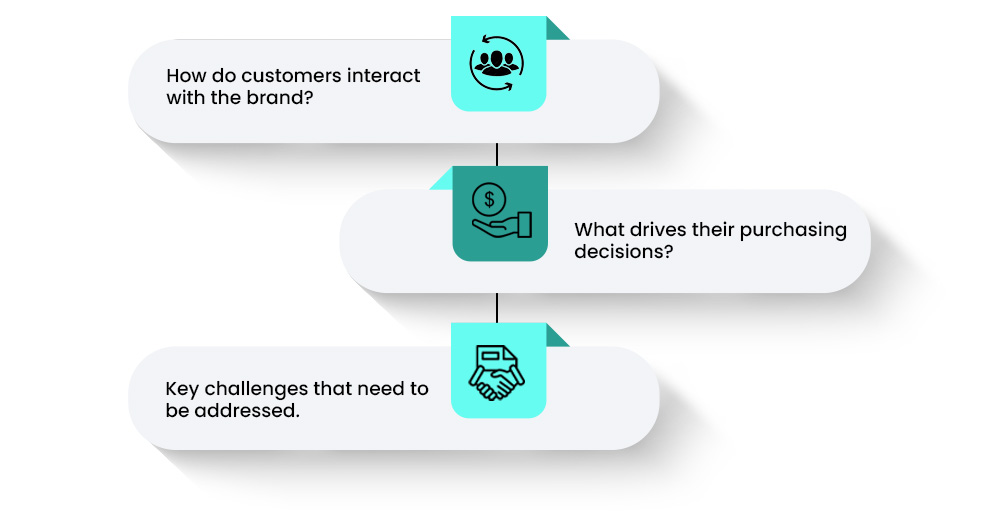
By diving deeper into the target audience’s mindset, businesses can fine-tune their products, messaging, and marketing strategies to better align with customer expectations and enhance engagement.
Increases Revenue and Business Growth
A clear and consistent brand doesn’t just look good—it helps people choose you, stay with you, and come back again. That’s what drives real growth and revenue.

A brand audit brings everything together. It aligns your messaging, marketing, and customer experience. When these elements work in sync, customers connect more easily. They trust the brand, stay loyal, and are more likely to buy. It’s not just about fixing what’s broken. It’s about sharpening what works. That’s how brands grow. And that’s how revenue increases.
Maintains Brand Consistency Across All Platforms
Consistency builds trust, and people notice when it’s off. A brand audit goes beyond checking logos and colors. It looks at how your brand comes across in every part of your business—whether it’s your website, social media, ads, packaging, or even how your team interacts with customers.
E.g., if your brand is fun and casual on Instagram but feels rigid and formal in your emails, it confuses customers. They don’t know what to expect from you.
A brand audit helps spot these mismatches. Once you see where things are off, you can adjust your approach to make everything feel more connected. When your brand is consistent across the board, customers feel more confident and loyal, making it easier for them to engage with you.
Protects Your Brand Reputation
A company’s reputation is one of its most valuable assets. A brand assessment helps ensure that your brand messaging reflects your core values and commitments, minimizing risks to your reputation. It helps businesses by:
- Identifying any gaps between what they say and what they do.
- Addressing negative customer feedback promptly.
- Ensuring that ethical and responsible practices are followed across the brand.
Regular brand audits allow companies to protect their reputation, build credibility, and maintain customer trust over the long term.
8-Step Guide to Conducting a Brand Audit
Here’s a step-by-step breakdown to help you audit your brand with clarity and purpose.
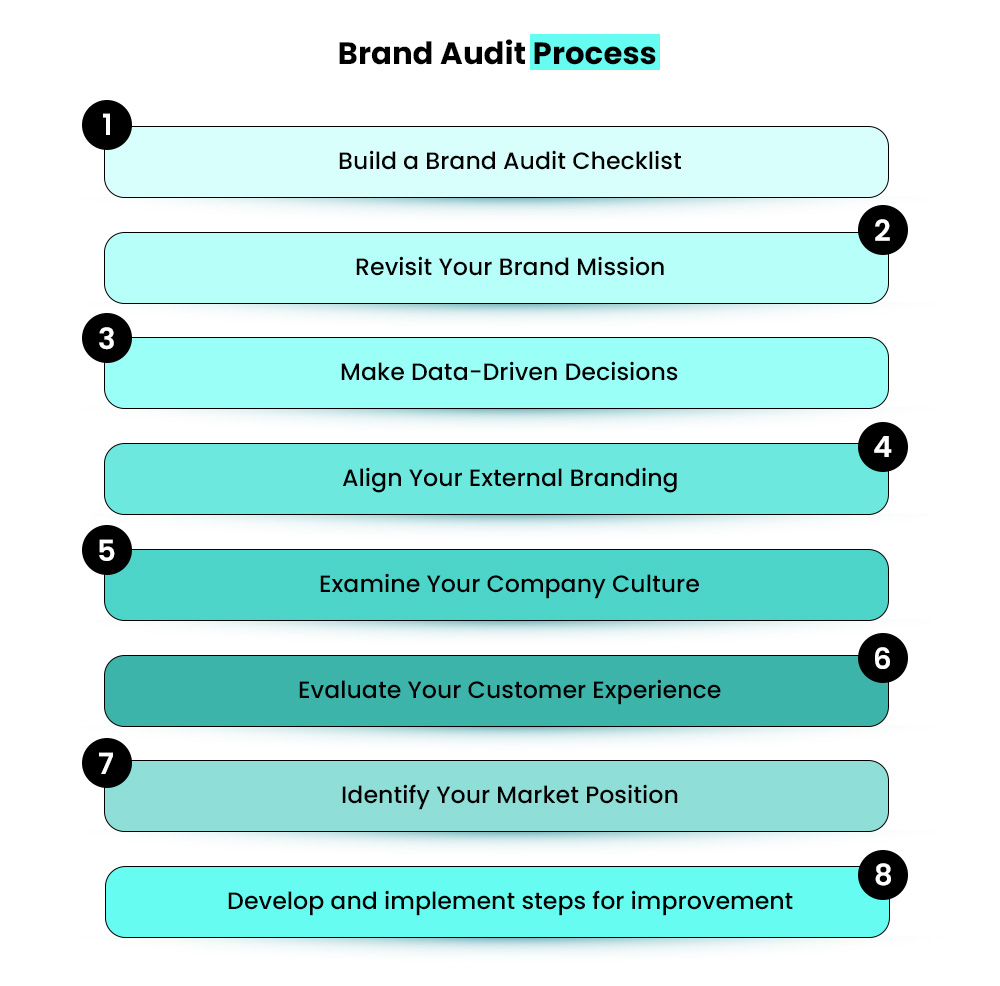
1. Build a Brand Audit Checklist
The first step is to get organized. Before you dive into data or design, you need to know what exactly you’re auditing. A checklist will help keep your focus sharp and your process thorough.
Think of your brand as made up of different layers: visual identity, voice, customer experience, internal culture, and how you’re seen in the market. Your checklist should cover each of those areas to ensure nothing is overlooked.
Here’s What to Include:
- Visual Identity: Is your logo still effective? Are your colors and fonts consistent?
- Messaging: Does your tagline or tone reflect who you are today?
- Digital Channels: Is your website clear, fast, and mobile-friendly? Does your social media reflect your brand?
- Customer Touchpoints: What kind of experience are people having at each stage, before and after they buy?
- Competitor Positioning: Who are your main competitors, and how do you compare?
- Internal Brand Culture: Do your employees understand and support the brand?
- Content and Campaigns: Are your recent ads or content pieces in line with your brand story?
Starting with a checklist keeps you on track and helps you avoid missing critical areas.
2. Revisit Your Brand Mission
Many brands write a mission statement when they launch, and then forget about it. But your mission is more than a sentence on your About page. It’s the core purpose behind your brand and should influence every decision you make.
Over time, companies grow, evolve, or pivot. It’s essential to stop and ask:
- Does your mission align with what your customers value today?
- Do your customers clearly understand what your brand stands for?
- Is your mission evident in everything you communicate and do?
E.g., Patagonia’s mission, “We’re in business to save our home planet,” goes beyond just a catchy phrase. It’s woven into everything they do. From choosing sustainable materials to making sure their supply chain is eco-friendly, every decision reflects this purpose.

They even encourage customers to buy less with their “Worn Wear” program and donate profits to environmental causes. By living their mission in such a real, everyday way, Patagonia builds trust and loyalty, proving to customers they’re committed to more than just business.
If your mission feels incomplete or disconnected from your daily operations, it’s time to rewrite or refine it and make sure your team lives it out.
3. Make Data-Driven Decisions
You can’t improve what you can’t measure. A brand audit needs to be grounded in real data, not assumptions. This is how you gain a clear, honest view of how your brand is truly performing across all channels.
Start by Collecting:
- Website Analytics: Bounce rates, time on site, most visited pages.
- Social Media Performance: Engagement, follower growth, and reach.
- Customer Feedback: Use surveys, reviews, and support tickets to see how people feel about you.
- Email Performance Metrics: Open rates, click-through rates, and unsubscribe patterns.
- Sales Data: What products or services are performing well, and which ones aren’t?
For instance, a decline in email open rates might indicate ineffective subject lines or a change in what your audience cares about.
Tools to consider:
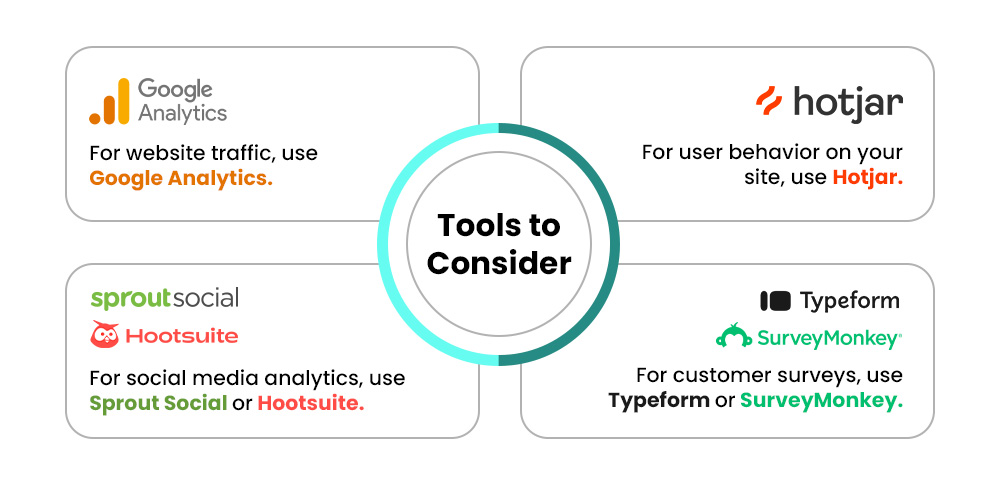
The goal is to find trends. Is engagement up or down? Are people converting from social? Are your reviews improving or declining? Data turns a brand audit from guesswork into action.
4. Align Your External Branding
Your brand is defined by how people perceive and interact with it, not just by what you claim it to be. This step is about making sure the outside matches the inside. That includes your visuals, your brand voice, and how consistent your brand looks across every platform.
Here’s Where to Look:
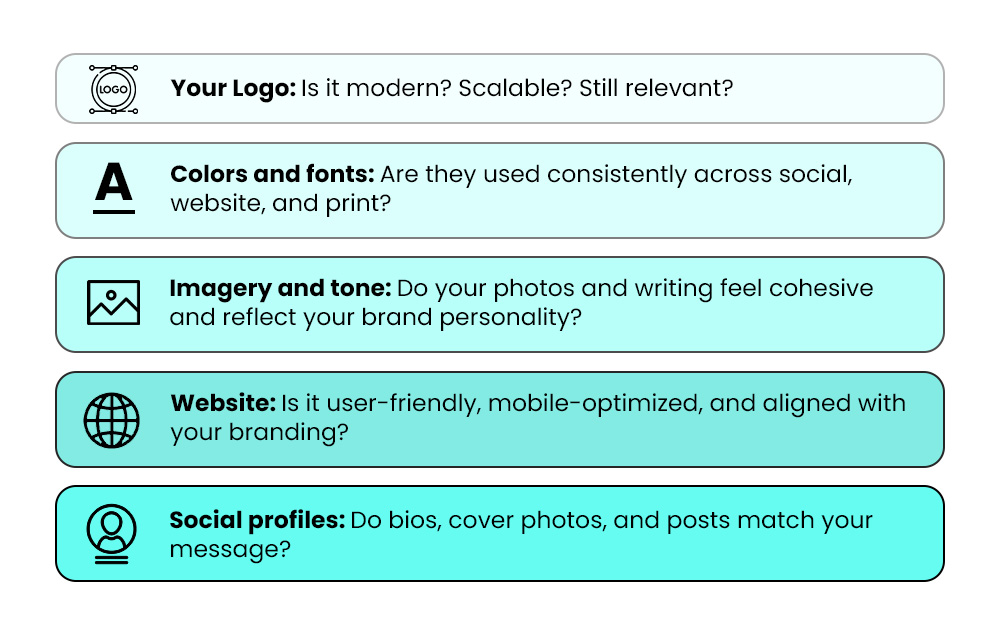
Common Problem
As brands grow, they often hire new agencies or try different strategies. This can lead to mismatched visuals across platforms. Different teams may use different styles, colors, or messaging. These inconsistencies confuse customers and damage brand credibility.
E.g., Mailchimp’s distinct, playful visual style is seamlessly integrated across all platforms, like email templates, landing pages, and even loading screens. This consistent use of design elements reinforces their brand identity, creating a cohesive experience that builds trust and enhances customer loyalty.
5. Examine Your Company Culture
Your brand isn’t just built on logos or taglines, it lives in the everyday actions of your team. If employees don’t connect with or understand the brand, it shows in their work. And customers notice. That’s why a strong internal culture, one that aligns with your brand values, is essential. When your team believes in the brand, it reflects in every customer interaction.
To Audit Your Culture:
- Talk to employees at all levels. Ask them what they think the brand stands for.
- Review internal communications and training materials. Do they align with your brand values?
- Observe how leadership talks about and lives out the brand.
- Check hiring and onboarding practices. Are new hires being set up to live the brand?
Gallup reports that companies with engaged employees are 21% more profitable. This shows that when employees are aligned with the brand, they contribute to stronger customer relationships and better problem-solving. A team that lives the brand will naturally reflect that authenticity in customer interactions, driving success.
Even the best marketing efforts won’t overcome the disconnect if your internal culture doesn’t reflect your brand.
6. Evaluate Your Customer Experience
Your brand is shaped by every interaction. It starts with the first ad someone sees. Then comes your website, and how easy it is to use. The checkout process matters too. So do shipping updates. Customer service and follow-up emails also leave an impression. Every step builds how people experience and view your brand.
Ask Yourself:
- Is the buying process easy and user-friendly?
- Do customers feel valued after they purchase?
- Are there common complaints in reviews or support tickets?
- Do all touchpoints reflect your tone, values, and quality?
E.g., Apple’s branding isn’t just about design—it’s about experience. Unboxing a product, visiting a store, or calling support is part of what makes their brand premium.
If your customer journey feels disjointed, your brand perception will suffer, no matter how great your product is.Identify Your Market Position
7. Identify Your Market Position
Where do you stand in your industry? Are you seen as a leader, a follower, or just another option? This step helps you see how your brand compares and what makes you different.
How to do it:
- List your top 3–5 competitors based on market relevance and audience overlap.
- Collect data on their messaging by reviewing their website headlines, taglines, and social media bios.
- Compare pricing models; create a simple chart to see where you stand in terms of value.
- Read 10–15 customer reviews per competitor to understand what customers praise or complain about.
- Use tools like Brandwatch or Mention to monitor how people talk about your brand vs. theirs, track mentions, tone (positive/neutral/negative), and engagement.
E.g. Drunk Elephant followed this exact approach. They studied the market and identified leading competitors who focused on luxury pricing or clinical solutions. Instead of matching those models, they spotted a gap where consumers wanted non-toxic skincare with visible results. By analyzing competitor messaging and customer reviews, they saw frustration around confusing ingredients and harsh products.
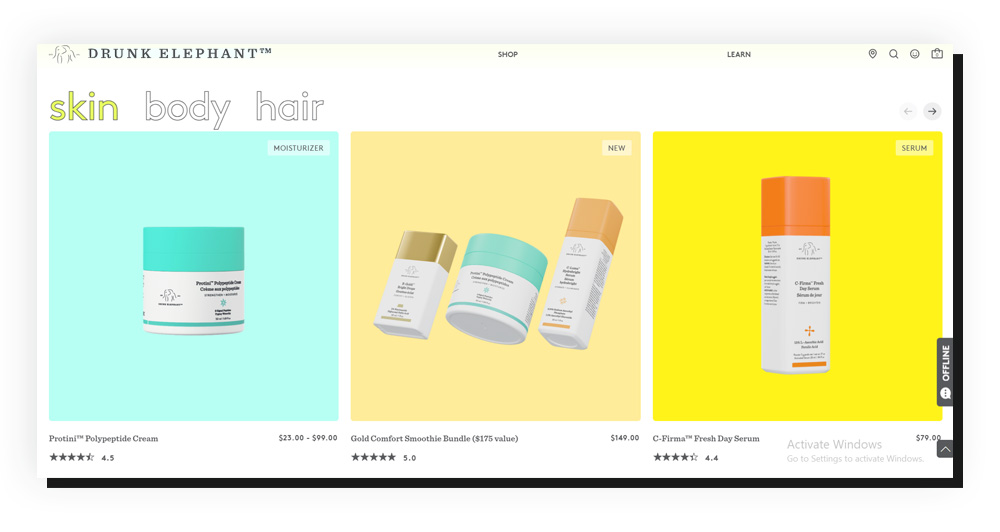
Rather than lowering prices, they built their brand on “clean beauty” with clear, ingredient-conscious branding. Their bold differentiation and clear niche gave them a strong position and a loyal customer base, long before “clean beauty” became mainstream.
When you know what sets you apart, you can rely on it. When you see where you’re behind, you can work on it.
8. Develop and Implement Ateps for Improvement
Once your audit is complete, the goal isn’t just to have a report, it’s to act. Prioritize what needs fixing, what needs refreshing, and what’s working well.
Create an action plan:
- Rank issues by impact (e.g., inconsistent branding vs. unclear product messaging)
- Assign tasks to relevant teams
- Set timelines for each change
- Revisit your audit every 6–12 months to track progress and make it an ongoing process, not a one-time task.
E.g., Dropbox followed these exact steps to reposition their brand. After auditing their messaging, they found it was too focused on features.
By analyzing competitors like Google Drive and listening to user feedback, they saw an opportunity. They shifted to an emotionally driven message centered around creativity and collaboration. This change helped them reach a wider audience and stand out in a crowded market.
Don’t try to fix everything at once. Start with the highest-impact gaps, such as inconsistent brand messaging or a poorly performing customer touchpoint.
Conclusion
A brand audit shows you what’s going on; what’s working, what feels off, and where you can grow. It takes the guesswork out and gives you a clear starting point.
If you’re feeling stuck or unsure of what to tackle first, that’s okay. At Mastroke, we help businesses make sense of all this and take the right steps forward.
Let’s make sure your brand shows up the way it should. Get in touch—we’re here to help.
Frequently Asked Questions
1. How often should I conduct a brand audit?
It’s a good idea to carry out a brand audit every year to keep your brand in sync with your business goals and what the market expects. But if something big happens—like a rebranding, expanding into new markets, or a noticeable change in how customers engage with you—it might be time for a more immediate audit.
Must Read: Branding vs. Rebranding: What’s the Difference and Importance?
2. Can small businesses benefit from a brand audit?
Absolutely! For small businesses, a brand audit can reveal ways to stand out in the market, ensure your messaging is consistent, and strengthen your connection with customers—all of which are vital for growth.
3. What’s the difference between a brand audit and a marketing audit?
A brand audit focuses on your brand’s identity, positioning, and how it’s perceived, while a marketing audit looks at how well your marketing strategies and campaigns are performing. Both are important, but serve different roles.
4. What are the common mistakes to avoid during a brand audit?
Be sure to steer clear of ignoring customer feedback, skipping competitor analysis, neglecting to act on the findings from the audit, and leaving out key stakeholders from the process. These pitfalls can result in an audit that’s either incomplete or ineffective.
